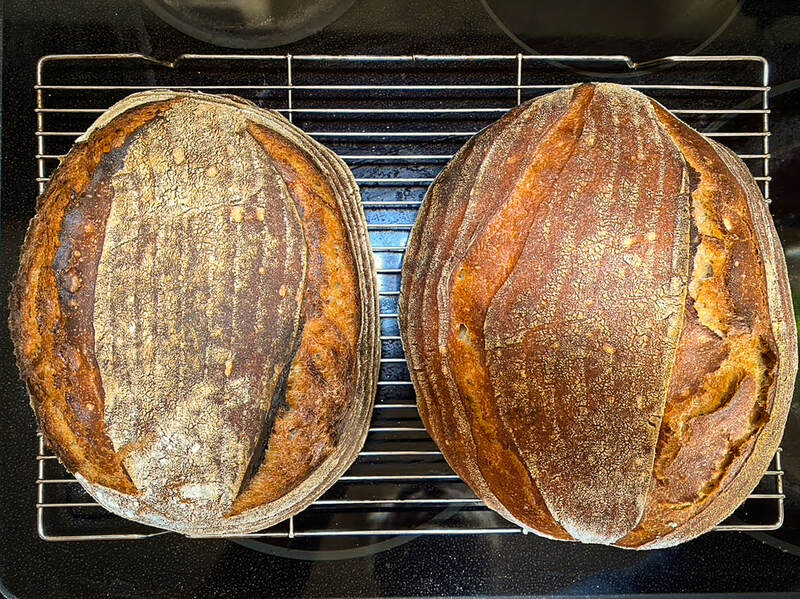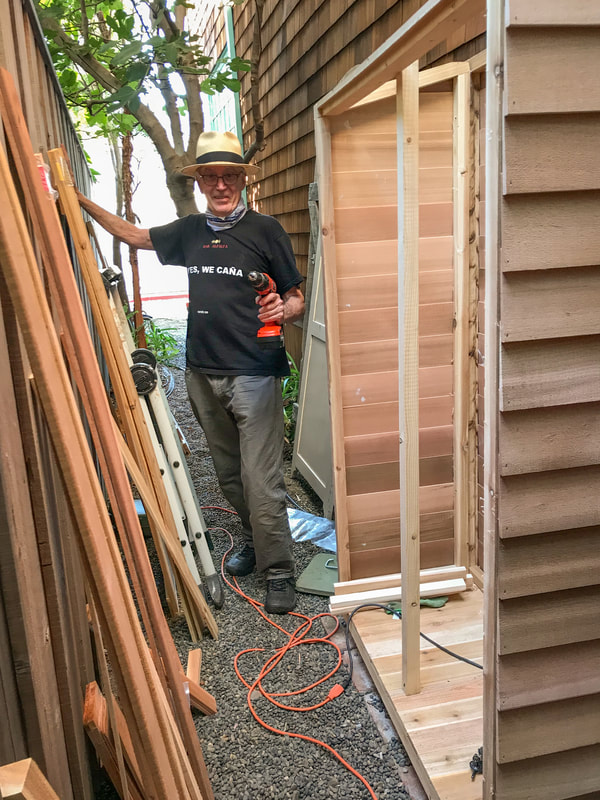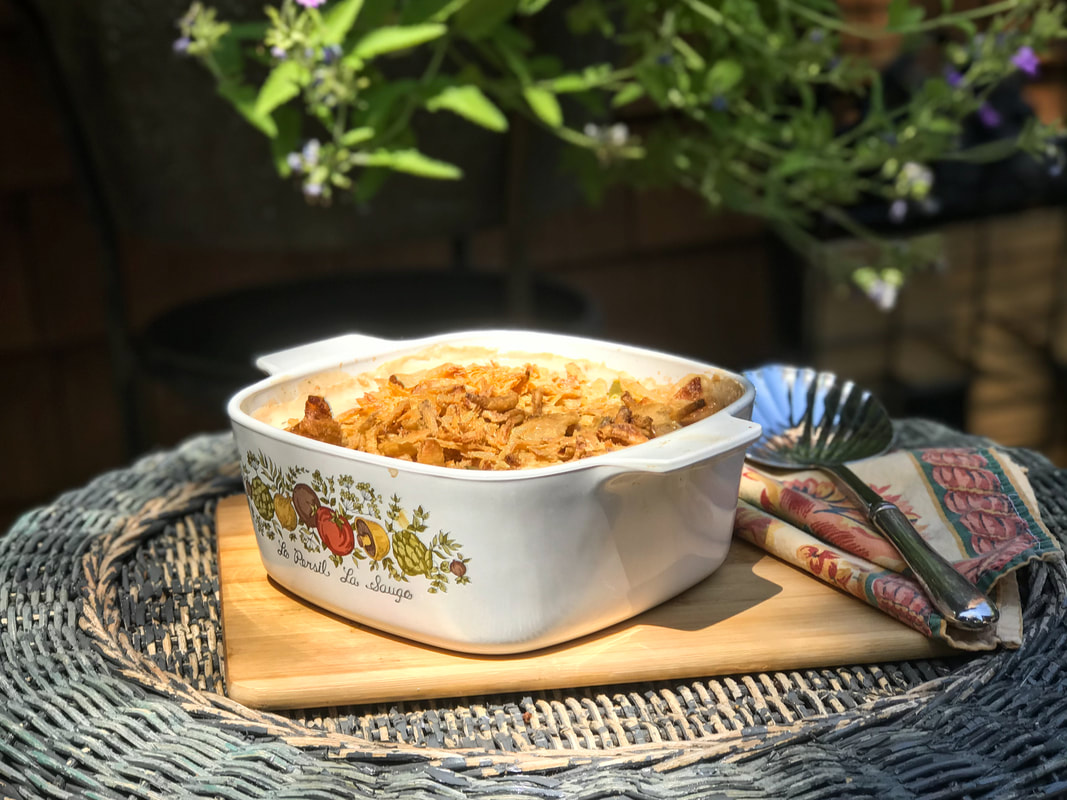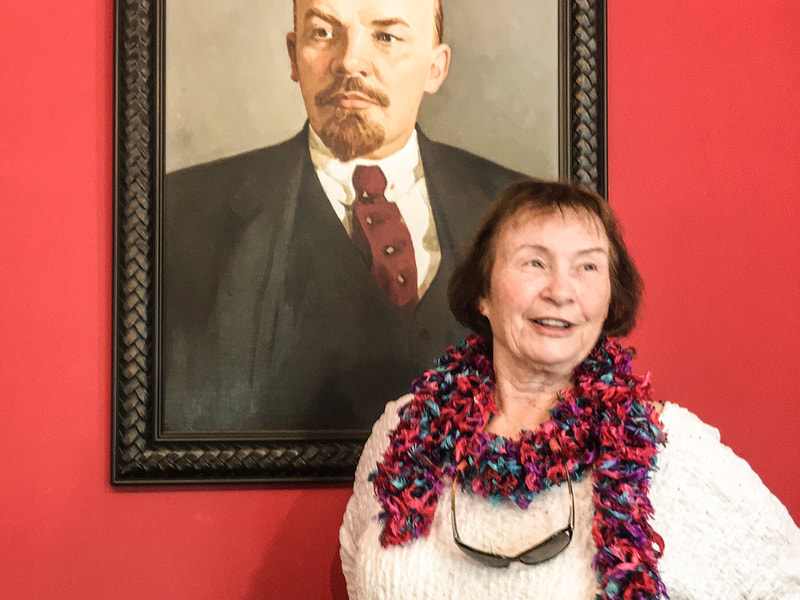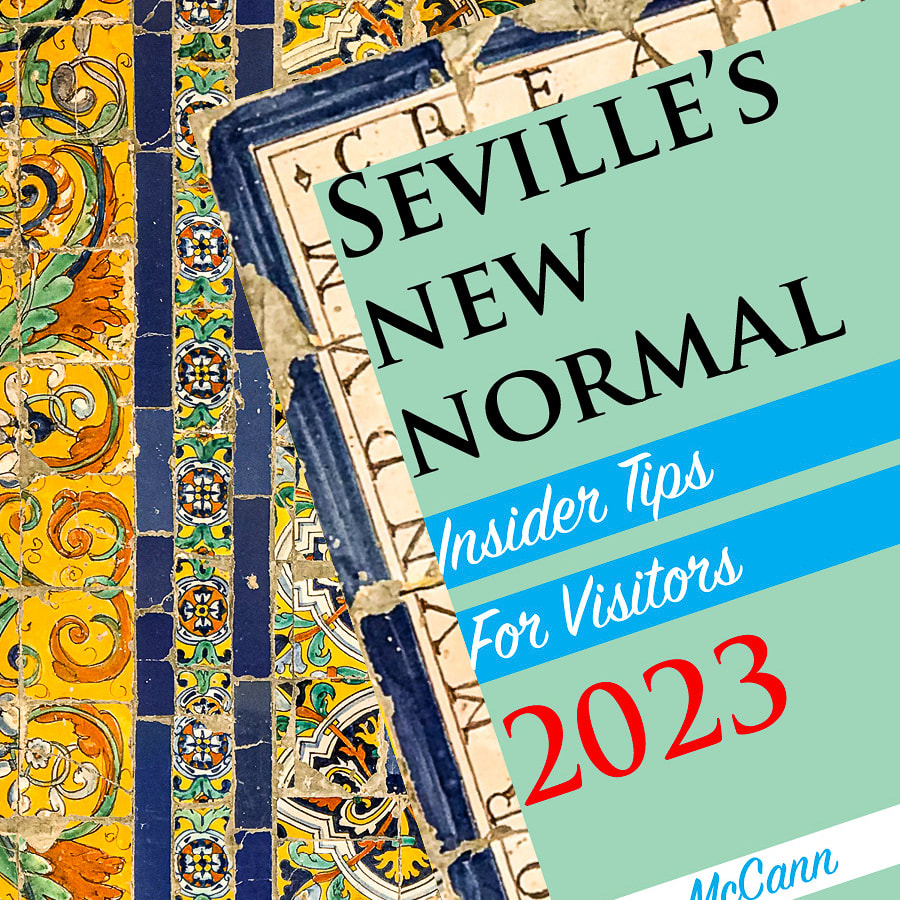|
Juggling six kids with a 17-year age range and non-stop personalities, my mom became an expert at deflecting disaster. One of her best tricks was simply redefining the situation to suit her purposes. Take the summer I was nine and her car kept breaking down, which in those pre-cellphone days meant long walks home or to the nearest telephone booth. About the fourth or fifth time it happened, she coasted to the side of the road, turned around, and said brightly, “OK, kids, everybody out. We’re going to have an adventure!” And I said, “Aw, Mom, how come every time we’re having fun we have to go and have an adventure?” I feel a bit the same way now. Six months ago I was zipping along, leading my life, writing a travel book, hanging out with friends in Spanish cafés, having fun — and then, like everyone, I was plunged into the great, cataclysmic adventure of our times, the pandemic. Even my mom would have been hard pressed to put a positive spin on this one. But if she were here now, no doubt Mom would be busy devising strategies for helping us get a grip on our courage, our perspective, and our sense of humor. Keeping our composure isn't easy when we’re all suffering from persistent anticipatory anxiety, which psychologists now call “pre-traumatic stress reactions.” Fun fact: this informal but commonly used diagnosis originated in a satirical article in The Onion about soldiers suffering from “Pre-PSD” on the eve of battle. Now the entire global population is afflicted, and symptoms flare up at the first glimpse of the morning’s grim headlines. As my reader Lynne wrote me in response to last week’s post, “I’m really struggling with it all, nothing makes sense and there’s an awful anticipation that there could be worse to come.” Sad but true for all of us, Lynne! With the pandemic and other disasters (yes, California wildfires, I’m thinking of you) continuing remorselessly on, how can we hope to keep our mental equilibrium? Can we find ways to take a break from all the doom and gloom? Yes! Aside from the obvious — wine, chocolate, and yoga — here are the simplest, most effective, mind-clearing, soul-restoring strategies I know. 1.Schedule something to look forward to. While waiting around for the next disaster, why not add something to the agenda we can anticipate with pleasure? I’ve written before about how explorer Earnest Shackleton organized weekly entertainments to keep his crew sane during more than two years trapped in the Antarctic ice. Dogsled races and head shaving aren’t practical in my current circumstances, but Rich and I organize a date night every week or so, with a theme such as 1950s sci-fi, dive bar hopping, going to a drive-in movie, or having a picnic. This week we’re holding a Cary Grant marathon; so far we’ve watched Arsenic and Old Lace, His Girl Friday, and Charade. (Want to help us decide which of his other films to watch? Leave suggestions in the comments below.) 2. Eat well. I used to love dining out, but now the very thought of being unmasked around dozens of barefaced strangers makes me jittery. I know what happens to everyone’s caution (especially mine) after the second glass of wine! So I’m staying home and cooking comfort food — the kind with healthy, wholesome ingredients to satisfy the body and scrumptious flavor to gratify the soul. This being peach season, a few days ago I made Yogurt Peach Pie for the first time in ages, using a recipe given to me decades ago by my mom's sister, Beverly. Even before I served the last slice Rich made me promise to make another soon. Like immediately. [Get Aunt Beverly's Yogurt and Peach Pie Recipe here.] 3. Organize projects. Rich is happiest when he’s deep into home improvements, so as soon as we returned from Spain in May, I suggested we finally renovate a long-ignored section of garden where an old fence was perilously close to collapsing onto the street. Over the past three months we’ve spent countless hours checking out neighbors’ landscaping and debating the finer points of gates, shrubbery, and brick vs. gravel. He loves the technical side, I love playing with the aesthetics. The heavy lifting has just been completed, and we have months more fun ahead doing the fiddly bits with flowers and lighting.  A carpenter we know made us a new garden gate from some old barn planks, and I let the paint bring out the fabulous scars and grain in the wood. The inset window is actually an old rusted floor vent; I ordered it online, and when it arrived I was delighted to discover the flaps still open and close. 4. Perform acts of kindness and connectivity. Boy Scouts are required to do a good deed every day, and if we all did, the world would be a better place. Social distancing eliminates many of the classics, like helping old ladies across the street. But we can reach out to friends, family, colleagues, and communities with emails, Zoom calls, and cheerful comments on social media. Each contact, however small, serves as a welcome reminder that at least we’re not facing this horror show alone.  Through the magic of Zoom, we've connected with Rich's old Navy buddies, attended a friend's poetry reading, participated in a town hall meeting for retrofitting the town's sidewalks for social distancing, and spent countless hours talking with friends and family about where this crazy situation is headed. 5. Learn something new. I recently watched a Netflix documentary on memory which demonstrated how poorly humans recall events and speculated about how such a faulty system could possibly offer any evolutionary advantage. Scientists showed how the parts of the brain that network to remember events are the same ones used to envision the future. Turns out memory’s value lies not in recording the past but in collecting data that enables us to piece together ideas about what’s likely to happen next. “Your mind is a time machine,” said the narrator. Viewed that way, “it looks like a superpower, the key to our success as a species.” Right now, that’s one superpower most of us don’t want. Our brains are flooded with terrifying images of the present — the pandemic, teetering economy, rising sea levels, my home state in flames — that leave little room to hope for a secure future. But as Helen Keller pointed out, "Security is mostly a superstition. It does not exist in nature, nor do the children of men as a whole experience it. Avoiding danger is no safer in the long run than outright exposure. Life is either a daring adventure, or nothing." So I guess I finally have my answer to the question I asked Mom all those years ago. How come we keep having our fun interrupted by adventures? Because life happens outside our comfort zone. Right now our superpower — having our brains hardwired to ransack our memories for components with which to assemble images of probable futures — is giving us all nightmares. But in the long run, if it helps us get our heads around the shape of things to come and take action, it could boost our chances of survival exponentially. In the meantime, we can rely on useful and creative work, connecting with the people we love, and our own stout hearts to sustain us on the bumpy road into tomorrow. Good luck out there! Let me know how you're holding up. And send me suggestions for Cary Grant classics to watch during this week's movie marathon. Up next: Humphrey Bogart. YOU MIGHT ALSO ENJOY Stay in touch!
Lots more pandemic coping strategies and comfort food recipes to come.
25 Comments
“I can’t believe I just did that,” a flustered stranger exclaimed to me, hurriedly pulling on a face mask in the supermarket. “I’ve been walking around this store for twenty-five minutes and forgot to put on my mask.” “Well,” I began. “Occasionally we all…” “And I’d just driven all the way home to fetch it, because I’d left it behind.” “I do that," Rich said. “Yeah? Well, you’ll never guess where I found my purse,” she said. “In the refrigerator.” OK, I had to admit, that did take absentmindedness up a notch. But these days, being discombobulated is everybody’s default state. Months spent absorbing catastrophic news has left us all, at times, feeling that our brains have been scrambled, fried, and turned to mush. Obviously the still-out-of-control pandemic looms large in our anxiety landscape, but here in California (and plenty of other places) extreme weather conditions are adding fresh disruptions and distractions to the scene. When unusually high temperatures hit the Bay Area on Thursday, it took about five minutes for air conditioners to overwhelm the grid. Officials sprang into action, organizing days of rolling blackouts. Now, even when we have power, internet connection is fragile, with frequent delays and long stoppages. We’ve lost phone service seven times. I can’t help drawing comparisons to last summer, the hottest on record in Europe, during which Rich and I traveled for 5,234 miles through 10 countries and never experienced a blackout or lost connectivity. It’s a sad state of affairs when California’s infrastructure can’t keep up with Albania’s. And now the fires are starting in earnest. In the last 24 hours some 10,849 lightning strikes have sparked 367 conflagrations in our area. Ash is drifting down in our garden, and officials warn we may be told to flee for our lives at a moment’s notice. Luckily our town, San Anselmo, is many miles from the action, so Rich and I aren't likely to be evacuated. Which is good, because clearly they have no idea where to put us. In past emergencies, everybody jammed together in some high school gymnasium with abundant air conditioning, Red Cross cots, and rehydrating sports drinks. But this summer's socially distanced evacuation means driving to a parking lot and staying in our cars. In 103 degree heat. For an unspecified length of time. Using communal Porta Potties. Sound like fun? “Do you ever feel like civilization is crumbing down around our ears?” I asked. “We have to change the chip in our heads,” Rich said. “This is our life now, and it will be for months, maybe years. Possibly the rest of our lives. The question is, how are we going to get our arms around it? Figure out how to live? Get good at surviving catastrophes?” My survival strategies start with the small stuff: being meticulous about charging electronic devices, keeping the gas tank at least half full, and having a good audiobook on my laptop for evenings without electricity; listening is so relaxing I’m usually asleep by nine. Between outages, I rush around baking bread, doing laundry, and — starting soon — buying the emergency supplies we’ll store in the Apocalypse Chow food locker. Rich has been laboring mightily all week to assemble this small “garden chalet” from a complicated mail-order kit. I’m pleased to report that, despite the crushing heat and multiple blackouts (the power grid's, not Rich's), he’s completed all thirty-nine assembly steps and, in a stunning breakthrough, even figured out where the leftover piece of wood was supposed to go. But Rich isn’t resting on his laurels. “We need to up our game,” he said, in the serious tone he uses to justify buying a new toy. “I think we should get a generator. A little one to keep the lights on, power a fan, and recharge our devices.” “Will it keep the fridge going?” I asked hopefully. “Probably not.” As Rich plunged happily into researching generators, I investigated other ways to keep food cold. Here’s what I’ve learned.
Meanwhile, Rich purchased his generator. “Look at this bad boy,” he said fondly. Naturally, the name stuck. Bad Boy is solar powered, so he’s smaller and quieter than his gas cousin, can be used indoors, and eliminates the worry of storing flammable fuels during fire season. He can be re-energized via any electric socket, our new solar panels, or the car’s cigarette lighter (handy in evacuee parking lot scenarios). Of all the survival strategies I’ve learned, the most useful is being helpful to one another. Last summer in Sarajevo, Bosnia, I talked to people about the 1990s when the city was surrounded by snipers in a siege that lasted 1,425 days. “That put a stop to everything you consider to be a normal life; there was only a struggle for survival,” recalled resident Haris Hadziselimovic. “No electricity, gas, food, water. You ate what you had and what you found.” With water lines destroyed and the river polluted, locals grew desperate for water. Salvation came from the local brewery, Sarajevska Pivara, built over a freshwater spring; they supplied the entire city with water, free of charge, for the duration. Rich and I were lucky enough to be involved in something similar on a miniature scale when we lived in Ohio. During the Northeast Blackout of 2003, we used our home's generator to pump water from our well, giving it to friends, neighbors, strangers. I’ll never forget how satisfying, even joyful it felt to hand a thirsty person a bucket of water. Today Rich, Bad Boy, and I are standing by to do whatever we can to be helpful in the days ahead. “Be kind whenever possible,” said the Dalai Lama, a man who knows something about hardship and chaos. “It is always possible.” YOU MIGHT ALSO ENJOY Get more survival tips, loony anecdotes & comfort recipes.
Follow my blog. Check out my Facebook posts. Try my Quarantine Comfort Cuisine recipes. So this is it, I thought, I really have sunk to the bottom. Aloud I said, “So tell me more about your grandmother’s Spam recipe.” If you’ve never tasted Spam, it’s a cheap canned pork product using unpopular parts of the pig processed into salty lunchmeat. In WWII the US army fed it to soldiers, who dubbed it "ham that didn't pass its physical" and "meatloaf without basic training." When I first encountered it in college, I thought it was the most ghastly food I’d ever eaten. Eventually it became a slang term for something equally unpalatable: junk email. “My grandmother used to fry Spam and put molasses on it,” my sister-in-law Deb reminisced fondly. “She called it ‘spackle.’” Repressing a shudder, I made a note to pick up some Spam and try it. No, I haven’t completely lost my sanity or my taste for Mediterranean comfort food. But desperate times call for desperate measures, and I am following official directives to stockpile emergency provisions. The immediate threat is California’s wildfire season. Last year, the utility company PG&E began shutting down parts of our electric grid when hot, dry, windy conditions made fires likely. We typically get 8,325 fires a year, destroying 1,126,318 acres, and PG&E has been responsible for some of the worst disasters — including the 2018 Camp Fire. The legal fallout from that one caused PG&E to declare bankruptcy and plead guilty to 84 felony counts of involuntary manslaughter. They are, to say the least, anxious not to repeat their mistakes. In a recent text, they reminded us fire-preventive outages are coming, so it would behoove us to stockpile provisions for two weeks. This being 2020, I have no doubt emergency supplies will come in handy. The problem is where to put them when I can barely fit everyday groceries into my modest cupboards. A food locker seemed the best answer. Rich, who is in his glory wielding power tools and manhandling lumber, ordered a kit for constructing a cedar garden shed small enough to squeeze into the skinny space between our house and the neighbor’s fence. As I mentioned in an earlier post, we dubbed it the Armageddon Food Locker or Apocalypse Chow. The manufacturer calls it a “garden chalet” — a grandiose term for a space two feet by four feet by six. In the online comments, one purchaser complained inferior instructions caused her husband to spend six whole hours on the assembly. “You’ll probably do it in half the time,” I told Rich encouragingly. Construction has now reached day five and Rich has completed 14 of the 39 steps required for assembly. Every morning the breakfast table is strewn with power tools, brackets, and stray screws as Rich drinks his coffee and glares at the instruction booklet. People keep asking what we’re going to put into the chalet, and that’s where I come in. I’ve been reading such articles as 14 foods to keep in your bunker to survive the apocalypse and The 11 Best Survival Food Companies of 2020. If you’ve never cruised these murky culinary backwaters, you're usually looking at large plastic tubs filled with freeze-dried packets of such dubious fare as Textured Vegetable Protein Stroganoff and Strawberry Flavored Creamy Wheat cereal. Costco currently offers a two-person 18-month supply of freeze-dried food at for $4,499.99 — a thrifty $124.99 per person per month. The contents, said to last up to 25 years, are somehow 100% vegetarian while including “chicken and rice soup.” I suppose in an apocalypse, all bets are off and chicken may be reclassified as a vegetable. Shopping for more modest quantities? Wired’s reviewer Matt Jancer says you’ll find freeze-dried packets “are expensive and unhealthy. For a pouch that'll supply you with 300-600 calories, expect to pay around $8. For one that supplies around 800 calories, you're looking at $13 or so. That's per meal. You don't need a calculator to know that adds up fast. Dehydrated food is also stuffed with salt. A single serving often has 30 to 40 percent of an entire day's recommended level of sodium. But one serving usually isn't enough to make a meal, so you'll inevitably eat both servings. In just one meal, you've almost hit your daily sodium target… that much sodium in your diet, day after day, is going to raise your blood pressure and make you feel like junk.” “I guess this stuff would be better than having to subsist on squirrels we hunt down and kill ourselves,” I said to Rich. “But only just. Remember the freeze-dried rice?” Returning from Spain in May, we’d discovered some freeze-dried rice left behind by a young nephew who’d recently self-quarantined in our house. I hadn’t eaten instant rice in decades, and in a spirit of scientific inquiry, I nuked some for lunch. The texture was limp and soggy, the flavor bland, the nutritional content negligible. I put down my fork, saying, “Is it even food? It feels like it's leeching sustenance right out of my body.” Long story short, I’ve nixed the freeze-dried products and am looking at actual food. Here’s my list so far.
Shopping starts when Rich finishes the chalet. I’m figuring late September; he says by Sunday. Place your bets in the comments below. As I stock up, I’ll check the site Eat By Date for advice on what sell-by dates to take seriously and which I can safely ignore. For instance, they say dried pasta is fine for an extra year or two and honey stays good “approximately forever.” With the ingredients on my list, I can make Irish soda bread, grilled chocolate sandwiches, and an old favorite from my impoverished twenties, green bean casserole; I cooked up some this week and found it still delivers a solid portion of culinary comfort. As for Spam, “Don’t knock it ‘til you’ve fried it,” says their website. Today I tried it, and yes, it is better when it's fried and covered with molasses (isn’t everything?). But with all due respect to Deb’s grandmother, spackle is still not delicious and/or healthy enough to make my emergency provisions short list. Even in desperate times — perhaps especially in desperate times — food should be an occasion of shared joy. If I learned anything from last year’s Mediterranean Comfort Food Tour, it’s that eating well is worth time and effort because it connects us to the present moment and to our companions in ways that nourish the soul as well as the body. As we all make the hard adjustments demanded by the new world disorder, meals can serve as a touchstone, reminding us life is worth living and that we’re better together. Omar Khayyam wrote, “A loaf of bread, a jug of wine, and thou beside me singing in the wilderness... paradise enough.” Add chocolate to that list and I think he might be on to something. Got any suggestions for my emergency supplies shopping list? Know any recipes using nothing but nonperishable ingredients? Have an opinion on if/when the food locker will be completed? Let me know in the comments below. YOU MIGHT ALSO ENJOY Want more survival tips and perspectives on our loony times? Just let me know where to send them. Can't wait? I post more or less daily on Facebook.
I’ve lost count of the times someone’s sent me “intelligent, you-should-read-this” coronavirus advice that turned out to be total hooey. Remember the (now debunked) Michigan doctor who told us all to wash our vegetables in bleach? Did you see the guy masquerading as Stanford Hospital board member who claimed holding your breath was an accurate coronavirus test? Now everyone’s talking about the infamous (quickly removed) America’s Frontline Physicians video promoting such discredited “cures” as hydroxychloroquine, zinc, and the antibiotic azithromycin while dismissing masks and quarantines as useless. One of the “experts” in the video was Dr. Stella Immanuel. Who’s that, you ask? “Immanuel, a pediatrician and a religious minister, has a history of making bizarre claims about medical topics and issues,” journalist Will Somer noted. “She has often claimed that gynecological problems like cysts and endometriosis are in fact caused by people having sex in their dreams with demons and witches. She alleges alien DNA is currently used in medical treatments, and that scientists are cooking up a vaccine to prevent people from being religious. And, despite appearing in Washington, D.C. to lobby Congress on Monday, she has said that the government is run in part not by humans but by ‘reptilians’ and other aliens.” OK, that last statement may be true and would certainly explain a lot. Such as why senior White House officials retweeted the America’s Frontline Physicians video, calling it a “must-see.” And yes, I find that deeply worrying. There’s a lot of crazy misinformation out there. So it’s up to each one of us to use common sense, stay skeptical, and double check our facts against the best scientific evidence we can find. Take face masks, for instance. Immanuel insists we don’t need them, but I beg to differ — as do the CDC and the World Health Organization. Even the famously unflappable British, who consider it cringeworthy to look ruffled or perturbed in a crisis, have begun requiring shoppers to wear masks. Until now, I’ve mostly been wearing my face shield, which according to infectious disease specialists offers “about a 96% reduction [in contagion], so it's very, very good.” In the Journal of the American Medical Association, Eli Perencevich, M.D., compared them favorably to masks saying, “We feel face shields are far more effective.” Then two weeks ago my friend Honey alerted me to a news item about a fancy restaurant in Switzerland. “After a coronavirus outbreak where only those wearing plastic visors were infected, the Swiss government has said plastic shields are inadequate protection and should only be worn in combination with a face mask.” Yikes! Unfortunately, there’s been little (actually, none that I can find) serious scientific study of face shields as protection against coronavirus. Opinions are plentiful and all over the place. For now, I'm favoring cloth masks for everyday outings while I continue my research. One thing I know for sure: I’m avoiding the MOYOF (mask of your own face) option. Journalist Heather Schwedel bought one for lighthearted entertainment but ended up describing the experience in words like “creepy,” “grotesque,” and “my skin crawled.” Sound like fun? You can commission one on Etsy, the crafts marketplace for under $20. Etsy vendor Bunny Giuliani told Schwedel, “I took pictures of some of my family and some of my friends and I started printing them on masks and wearing them out to the store. I’d wear my dad’s beard, stuff like that. It was a big hit.” She’s now sold thousands of personalized masks online. Giuliani said employees from a dentist’s office “bought the bottom half of the dentist’s face and they all wore it whenever they were cleaning teeth, to just be funny.” My California dentist, who last Halloween had everyone in his office dress up as characters from the Elton John biopic Rocketman, would probably love to do this. I can only hope and pray nobody turns him on to MOYOFs. These days masks are all about self-expression, sporting slogans such as “Black Lives Matter,” “Vote,” “Will remove for wine,” or obscenely phrased objections to mask wearing. The small, belligerent minority of aggressive anti-maskers continues to be active on social media. My post Risky and Ridiculous Business: The American Mask War drew some nasty attention from people who called me a dupe, a Nazi, a puppet, and mentally ill. You may not have seen their comments because I took down the ones that crossed the line into actual hate speech. “What are they going to object to next?” I said to Rich. “Hand washing? Anybody who uses soap is falling for left-wing propaganda?” Rich laughed. “I have something you need to see,” he said, and sent this to my laptop. I couldn’t have said it better myself. Meanwhile the press, which finds any juicy story irresistible, continues to give the loonier anti-maskers plenty of attention. Like the guy who walked into a cigar store in in Bethlehem, PA, and when asked to don a mask pulled out a handgun, stole a couple of stogies, and shot at a store clerk. Later he fired an AK-47 at the police. Thank God he’s a terrible shot; as far as I know nobody was hurt. In his defense, his lawyer said he was “not handling the pandemic well.” Is anyone? Let’s face it, navigating the pandemic is a nightmare. And while most of us are coping better than the cigar store gunman, we all feel overwhelmed at times. I’m one of the most optimistic people on the planet, and even I find myself caught up in dystopian gloom at times.  Growing up in the SF Bay Area, I've seen my city survive Godzilla, aliens, zombies, brain-enhanced apes, cyborgs, a giant octopus, a Bond villain, the Body Snatchers, and of course, killer earthquakes (as in this scene from San Andreas). Unfortunately, with the horror show of the 2020 pandemic, there's no guarantee of a happy Hollywood ending. But then there are the good days. Like when we really connect with the people we love (even if it’s on Zoom). And when our latest home improvement project turns out to be cheaper and better than we imagined (when does that ever happen?). Drive-in movies are making a comeback; we saw Speed the other night snug in our car. Animal shelters are emptying as people remember how cheering it feels to hug a furry friend. And Tom Cook and Joseph Feeney, who agreed back in 1993 that if either one of them ever won the Powerball jackpot they’d split the money, just divvied up $22 million. “He called me, and I said, ‘are you jerking my bobber?’” said Feeney, an avid fisherman. The odds of winning the Powerball jackpot are one in 292 million. Our chances of surviving the coronavirus? Considerably better. The likelihood that we’ll get the ‘reptilians’ and other aliens out of Washington in November? With some hard work, I think we might actually have a shot at it. And no, my friends, I’m not jerking your bobber. YOU MIGHT ALSO ENJOY If you enjoyed this post, send your email address and I'll notify you when new ones come out.
|
This blog is a promotion-free zone.
As my regular readers know, I never get free or discounted goods or services for mentioning anything on this blog (or anywhere else). I only write about things I find interesting and/or useful. I'm an American travel writer living in California and Seville, Spain. I travel the world seeking eccentric people, quirky places, and outrageously delicious food so I can have the fun of writing about them here.
My current project is OUT TO LUNCH IN SAN FRANCISCO. Don't miss out! SIGN UP HERE to be notified when I publish new posts. Planning a trip?
Use the search box below to find out about other places I've written about. Winner of the 2023 Firebird Book Award for Travel
#1 Amazon Bestseller in Tourist Destinations, Travel Tips, Gastronomy Essays, and Senior Travel
BLOG ARCHIVES
July 2024
CATEGORIES
All
|














